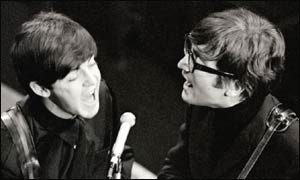| "Just Knocking Out a Bit of Work" John Lennon (in Davies 1985: 284) |
|
| An underlying aesthetic for them was seldom to write down the chords. "We had a rule that came in very early out of sheer practicality, which was, if we couldn’t remember the song the next day, then it was no good. We assumed that if we, who had written it, couldn't remember it, what chance would an ordinary member of the public have of remembering it?" (Miles 1997: 37). "The only thing that we would sometimes do to notate was literally write the name of the note over each word, we didn't have any tempo, you'd just have to remember how it scanned and its metre" (37). He also notes that their songs were "always quite quickly written, they were never protracted affairs" (38). |
| As for the composition process, McCartney says that he usually starts with "some kind of accompaniment" (148). That is, he would start with a chord progression and a general sense of meter and rhythm and adds words later. |
| Lennon: "But please, please don't copy. Try to be original as we have done. Play what you like and don't try to be too clever. Keep it simple" (Melody Maker 23 February 1963, 12). |
| Lennon:
On the music side, as far as I was concerned, if I found a new chord,
I'd write a song around it. I thought if there were a million chords
I'd never run out. Sometimes, the chords got to be an obsession and
we started to put all unnecessary ones in. McCartney: They started to get too complicated and "chordy." No, not like modern jazz, but just dripping with chords that weren't supposed to be there anyway. Lennon: We decided to keep them simple and its the best way. It might have sounded OK for us, but the extra chords wouldn't make other people like them any better. That's the way we've kept it all along. McCartney: The best time to write ... is sitting down. Seriously sitting down with a guitar or piano. Smoking helps too. Why guitar all the time? Not always. Sometimes your ideas get blocked on guitar. ... One night, I was trying to write one with a guitar, and I couldn't get it on the thing. I tried it on piano and it worked. Lennon: We don't sort of think of a catch phrase and write around it. It could be quite nice if a catch phrase comes to you, but it doesn't happen often. McCartney: Musically again, I don't think the stuff you do chordwise is quite as important as the tune and the words and the feel of the song. Chris Roberts. 1 February 1964. "Lennon and McCartney Tell You ... How to Write a Hit!" Melody Maker 11.] |
| For "Please Please Me," Lennon and McCartney had a valuable accomplice in George Martin. Martin's (1979: 132) account of the process is as follows: "I would meet them in the studio to hear a new number. I would perch myself on a high stool, and John and Paul would stand around me with their acoustic guitars and play and sing it — usually without Ringo or George, unless George joined in the harmony. Then I would make suggestions to improve it, and we'd try it again. That's what is known in the business as a 'head arrangement,' and we didn't move out of that pattern until the end of what I call the first era. That was the era which lasted through 'Love Me Do,' 'Please Please Me,' 'From Me to You.' 'She Loves You,' and 'I Want to Hold Your Hand,' which were the first batch of recordings." |
| Martin suggests that there "there wasn't much arranging to do." He saw his role as "to make sure that they made a concise, commercial statement." His aesthetics consisted of a time limit of "approximately two and a half minutes," that the performance was "in the right key for their voices, and that it was tidy, with the right proportion and form." His "specialty was the introductions and the endings, and any instrumental passages in the middle." (Martin 1979: 132) |
| McCartney: We were really interested in the idea of being real musicians, and in a way when you think of Lennon and McCartney it's Rodgers and Hammerstein because that's who we were emulating. All our heroes were just Chuck Berry, Little Richard and the rest. There might have been a little Goffin and King in there, because we were very keen on their stuff. So we were starting to be really good then, I think for me one of the great clinches was one morning hearing the milkman whistle, "Is there anything that you want?" I said that's it, I'm in; that was it really, I think that was the best compliment I've ever been paid to this day. I'd got home late from a club and me and the milkman were on the same wavelength; I was just getting into bed and I could hear him rattling his bottles outside and whistling From Me To You. I wrote that! That was a fabulous feeling, I must say: I could obviously go on and on for ever. (From George Martin, Making Music, 1983.) |
| "I Saw Her Standing There" | "She Loves You" | "I Want to Hold Your Hand" |
| "This Boy" | "A Hard Day's Night" | "If I Fell" |
| "I Feel Fine" | "Help" | "Yesterday" |
| Go to | ||
| Lennon & McCartney | Outline | Origins and Models |
| 03-Sep-2009 |
